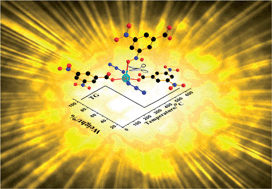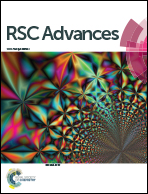3D high-energy-density and low sensitivity materials: synthesis, structure and physicochemical properties of an azide–Cu(ii) complex with 3,5-dinitrobenzoic acid†
Abstract
A novel 3D energetic coordination polymer of azide–Cu(II), Cu(3,5-DNBA)(N3), was synthesized and structurally characterized by single crystal X-ray diffraction, where 3,5-DNBA represents 3,5-dinitrobenzoic acid. Structural analysis reveals that the central Cu(II) ion coordinates with two azide anions and three 3,5-dinitrobenzoic acid anions to form a five-coordinated tetragonal pyramid structure. Remarkably, one oxygen atom in the nitro group displays rare coordination to the Cu(II) ions in the complex. The as-prepared compound showed abrupt thermal decomposition at 268 °C, representing explosive performance and superior thermostability based on DSC and TG-DTG analyses. Sensitivity tests revealed that the title complex was insensitive to external stimuli. The kinetic parameters of an exothermic process for the complex were studied by Kissinger's and Ozawa–Doyle's methods. In addition, the constant-volume combustion energy of the complex was determined using a precise rotating-bomb calorimeter, and the standard molar enthalpy of combustion and the standard molar enthalpy of formation were calculated.


 Please wait while we load your content...
Please wait while we load your content...